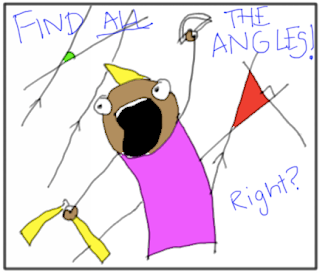I'm teaching fully remote this year and have been struggling with many aspects of it. Like one does.
My courses were scheduled online synchronous, hoping for ways to get these preservice teachers working with kids... which hasn't happened yet. We do an hour of synchronous time, then there's asynchronous time for the remaining, with a set assignment, and then homework for a time, usually with a fair amount of choice. Reading (NCTM journals, teacher blogs, ...) , video, problems, etc.
Today my class was pretty quiet. We do Zoom, using Jamboard for an interactive whiteboard. Often there are problems or discussions that start in breakout groups, randomized every few weeks, then come back for whole group discussion. Today, on our last day of trigonometry, we were tackling identities. I tried something new, which was going old school. We stayed whole group, I did an example, and then asked them to work individually and contribute.
I usually start out with a Jamboard data prompt, sometimes my question and sometimes theirs. (I share these pretty frequently on Twitter.) Today was their question, and I tried having a parallel chat, where I asked them 'what's the scariest math problem or course?'
The visual prompt was my favorite trigonometry diagram.
We talked a bit about the history, the mistranslation of sine, and a recurring theme for this unit, the connections between geometry and algebra.
We then looked at just one section together to get at the similar triangles we would be using.
We started with the triangle in the center. I shared how I learned from a student in the long ago to pull them apart and reorient them. We worked through three questions, where each time I left them more to fill in in the proportion. They had a minute to think by themselves, then we discussed. But only two students were willing to take the mic and share what they're thinking.So I asked them in the chat publicly to share how comfortable they were with these kind of problems, 0 = don't know how to start, 5 = confident they could solve them. I also asked them to privately message me a word about their participation. We've been using WAIT - Why Am I Talking or Why Aren't I Talking (from Jennifer White's great Desmos norm activity) as a framework for this.
Sorted (public):
1
3 3 3 3 3 3
3.5
4 4 4 4 4 4
4.5
5 5
Timeline (private):
- Wishing I was on fall break
- I think I am confused on the proportions. I'm not seeing where to get those.
- I guess I’m not uncomfortable participating in discussion, but I didn’t, and haven’t been lately, because I am really burnt out and need to just focus on listening
- I am at home and can’t really turn on my mic
- I'm just confused about why we are talking about sin, cos, and tan as side lengths, and not ratios of the sides.
- honestly I am fine with talking sometimes I knew my answer was wrong however but after switching the triangles around I really understood it
- I found these problems kind of confusing. I was listening to the others to see if I could understand it from there and that did help.
- Trig for me has always been a hard subject, it took me a lot longer to realize how all 3 triangles are related and then create the ratios
- I feel ok with talking, but there are times where I would say something ang you're talking but I can't raise my hand, I'm not sure how. So I never get to say my thought.
- I was not completely understanding the triangles
- I felt like I could follow along well enough, but couldn't really piece it together. I'm still half asleep, I'm not a morning person
- Very busy week with other classes and I’m trying to keep up with them too
- I've always had a hard time with trigonometry so I don't have a lot of confidence in answering those types of questions in front of class
- I could follow what was happening and what was being discussed, but I was struggling to answer the questions and explain the thinking behind them. But after they were explained, they make sense
- I would have felt comfortable speaking aloud because I understand this material
- I don’t like talking in front of the whole group because I’m afraid I’m going to be wrong. This stuff is sort of confusing, and I’m not terribly confident in my answer.
- I wanted to observe what other students come up with and have others the opportunity to do trig














